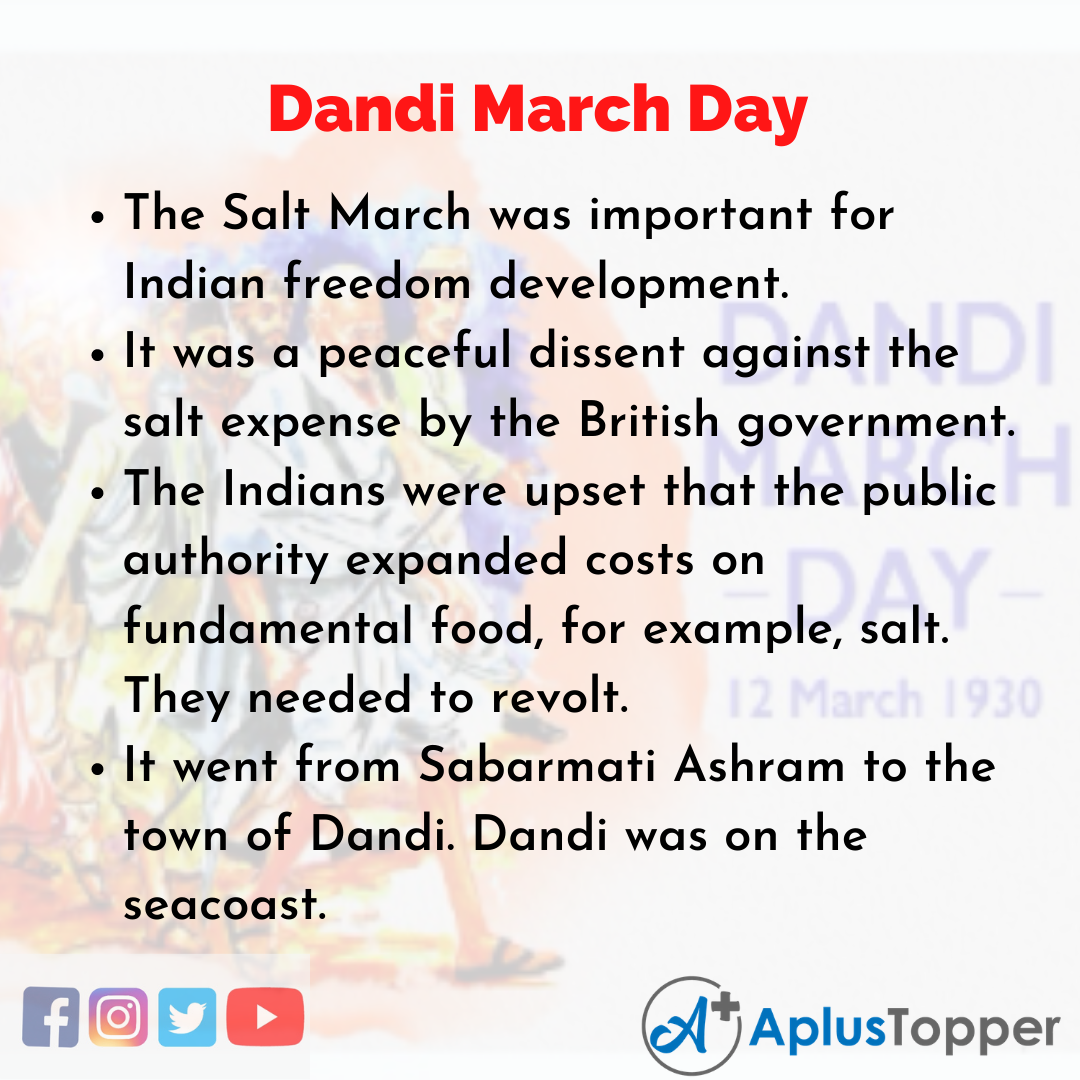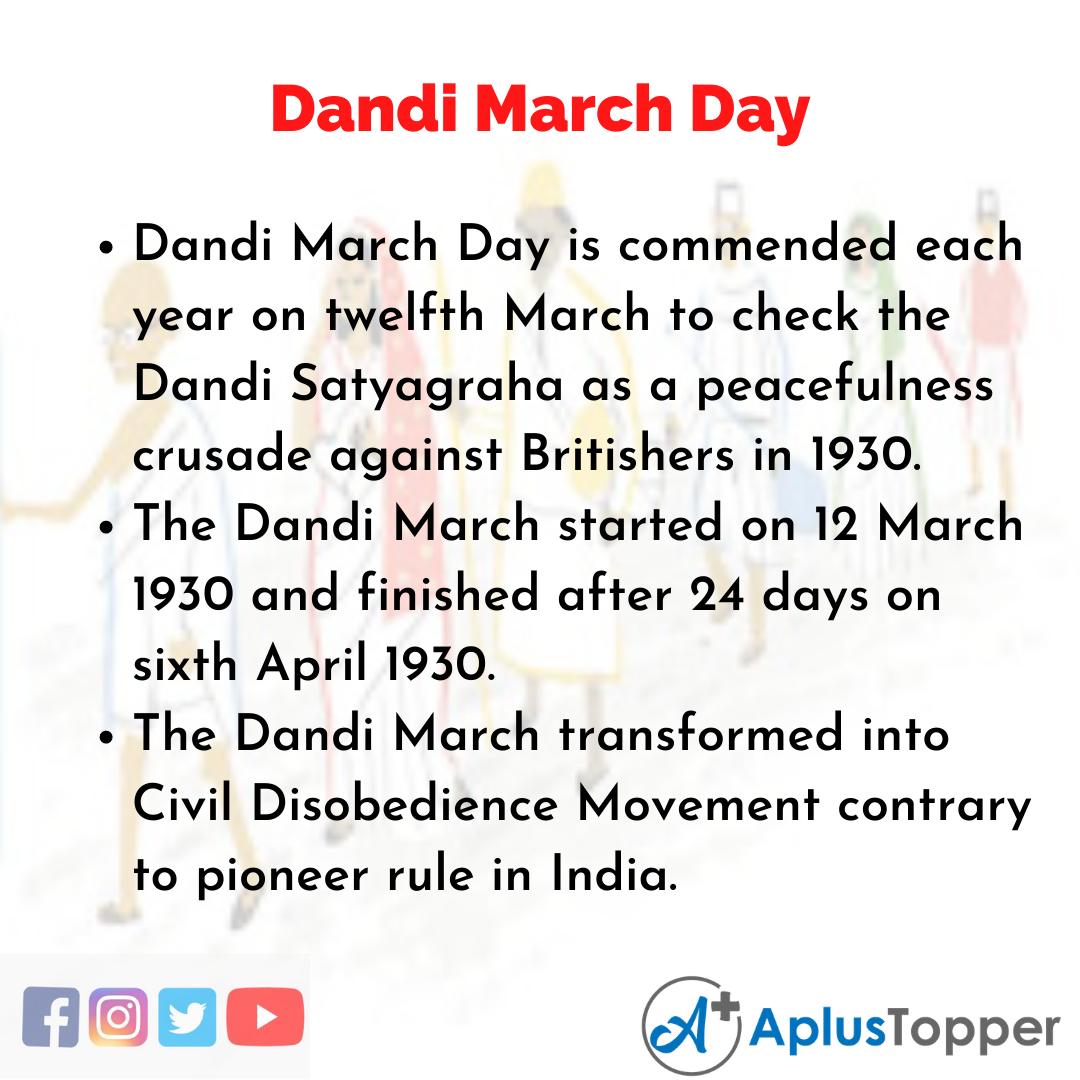10 Lines on Dandi March Day: One of the main occasions in India’s battle for autonomy occurred when Mahatma Gandhi dispatched the Civil Disobedience Movement with his well known Dandi March, which started on twelfth March 1930 and finished on April sixth, 1930.
Dandi March or Salt Satyagraha was a peaceful method for fight drove by Mahatma Gandhi, which accumulated tremendous public help and overall consideration. Gandhiji strolled from his ashram in Sabarmati in present Gujarat to the unassuming community of Dandi close to seaside Surat to challenge the pilgrim government’s oppressive salt expense. This walk covering the distance of approximately 385 km filled in as an impetus for India’s battle for Independence.
You can read more 10 Lines about articles, events, people, sports, technology many more.
Set 1 – 10 Lines on Dandi March Day for kids
Set 1 is helpful for 1st, 2nd, 3rd, 4th, and 5th class students.
- The Salt March was important for Indian freedom development.
- It was a peaceful dissent against the salt expense by the British government.
- The Indians were upset that the public authority expanded costs on fundamental food, for example, salt. They needed to revolt.
- Mahatma Gandhi drove the walk. It began on March 12, 1930.
- It went from Sabarmati Ashram to the town of Dandi. Dandi was on the seacoast.
- Marchers took a modest bunch of salt from the shore.
- British Raj had syndication over the creation and offer of salt in India.
- The salt laws disallowed Indians from delivering or selling salt without earlier authorization from the Government.
- Gandhiji had the option to comprehend the general arrangement of misuse and constraint under the British Raj of which salt law was a model.
- The salt laws were something, which influenced the whole populace of the nation.
Set 2 – 10 Lines on Dandi March Day for School Children
Set 2 is helpful for 6th, 7th, and 8th class students.
- Driving a gathering of 80 other Satyagrahis, Gandhi began this development from his base at Sabarmati Ashram and took 24-days to arrive at Dandi. Going along with him were individuals from different backgrounds and conditions of India.
- Before Gandhi could begin this walk, he sent a letter dated March 2, 1930, to Lord Irwin, British Viceroy, giving him notice of his goal and encouraging him to rethink the pioneer stand.
- While the walk proceeded through Gujarat, a gathering of housewives drove by Kamaladevi Chattopadhyay walked to Chowpatty in Mumbai.
- British Raj had syndication over the production of salt in India. Salt was a significant fixing in the ordinary eating routine of the individuals. This prohibition on salt deal and creation appeared to be outlandish and harsh.
- Gandhi imagined the arrangement of dispatching a salt Satyagraha that would make individuals mindful of the abusive system of British.
- This moment would impart in the individual’s certainty to resist British Raj.
- The peaceful methods for the fight by walking from Sabarmati Ashram to Dandi would attempt to stimulate individuals’ cognizance against the abuse of the public authority.
- Salt Satyagraha gave the occasion to join the country together for the reason that influenced everybody.
- Marchers at that point, declared that they had overstepped the law by making salt.
- Dandi march is also known as Salt march and Namak satyagraha.
Set 3 – 10 lines on Dandi March Day for Higher Class Students
Set 3 helps the students study in classes 9th, 10th, 11th, 12th, or preparing for competitive exams.
- Dandi March Day is commended each year on twelfth March to check the Dandi Satyagraha as a peacefulness crusade against Britishers in 1930.
- Dandi March demonstrated peacefulness development drove by Mahatma Gandhi to create salt from seawater in the town Dandi.
- The Dandi March was the walk of 50000 individuals as an image of dissent against the high duty demanded on Britishers’ salt in 1930.
- The Dandi March started on 12 March 1930 and finished after 24 days on sixth April 1930.
- The salt walk was peaceful in nature and was pointed toward creating unlawful salt as a dissent image contrary to British guideline.
- The Dandi March transformed into Civil Disobedience Movement contrary to pioneer rule in India.
- The Salt March was a 390 km long excursion which began at Sabarmati Ashram and finished at the coastline of town Dandi.
- The Dandi March drew the media consideration broadly and globally towards India’s freedom development contrary to frontier rule.
- Dandi March presented genuine difficulties to the British Empire and later turned into a vital development in India’s battle for Independence.
- Mahatma Gandhi Foundation puts together a salt walk crusade praised each year to check Dandi March’s occasion.
FAQ’s on Dandi March Day
Question 1.
What is the motivation behind the Dandi march?
Answer:
The Salt March’s motivation was not exclusively to act in insubordination of the salt laws established by the public authority yet, also, to join the individuals for the bigger objective of ‘Swaraj’.
Question 2.
Why was the Dandi March undertaken by Gandhiji?
Answer:
Dandi march was taken to avoid British monopoly over salt. They wanted the abolition of tax on salt.


